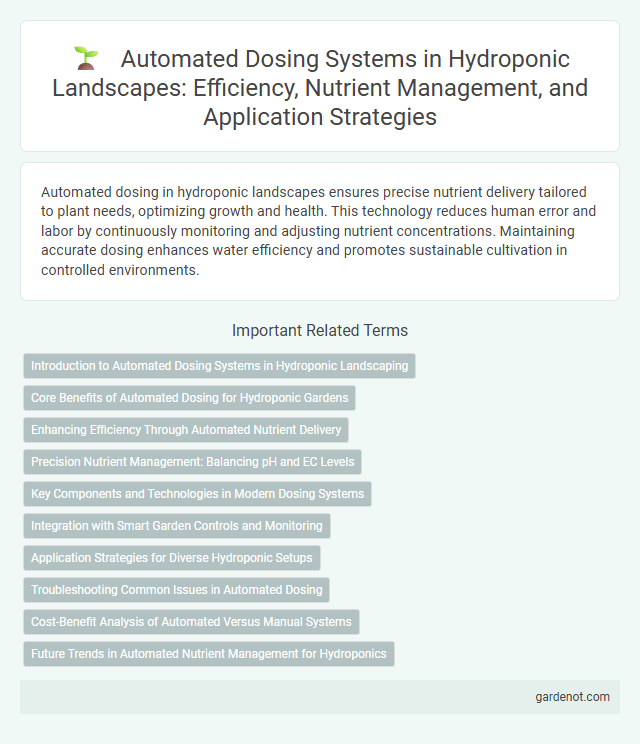Automated dosing in hydroponic landscapes ensures precise nutrient delivery tailored to plant needs, optimizing growth and health. This technology reduces human error and labor by continuously monitoring and adjusting nutrient concentrations. Maintaining accurate dosing enhances water efficiency and promotes sustainable cultivation in controlled environments.
Introduction to Automated Dosing Systems in Hydroponic Landscaping
Automated dosing systems in hydroponic landscaping precisely deliver nutrients and pH adjusters to optimize plant growth and minimize human error. These systems utilize sensors and programmable controllers to maintain ideal nutrient concentrations, enhancing crop yield and reducing waste. Integration of automated dosing technology ensures consistent plant health and efficient resource management in sustainable hydroponic operations.
Core Benefits of Automated Dosing for Hydroponic Gardens
Automated dosing systems in hydroponic gardens ensure precise nutrient delivery, optimizing plant growth and reducing human error. These systems maintain consistent pH and EC levels, enhancing nutrient uptake efficiency and overall crop yield. Reduced labor costs and minimized resource waste contribute to sustainable and scalable hydroponic cultivation.
Enhancing Efficiency Through Automated Nutrient Delivery
Automated nutrient delivery systems in hydroponic landscapes optimize plant growth by precisely adjusting nutrient concentrations based on real-time sensor data. These systems reduce human error and labor costs while ensuring consistent nutrient availability tailored to specific crop requirements. Enhanced efficiency through automation leads to higher yields, improved resource management, and sustainable cultivation practices.
Precision Nutrient Management: Balancing pH and EC Levels
Automated dosing systems in hydroponic landscapes ensure precise nutrient management by continuously monitoring and adjusting pH and electrical conductivity (EC) levels. Maintaining optimal pH between 5.5 and 6.5 enhances nutrient availability, while EC control prevents nutrient imbalances and plant stress. This technology maximizes crop yield and promotes healthier plant growth through consistent, data-driven nutrient delivery.
Key Components and Technologies in Modern Dosing Systems
Automated dosing systems in hydroponic landscapes utilize precision pumps, sensors, and controllers to regulate nutrient and pH levels consistently. Key components include peristaltic or diaphragm pumps, electroconductivity (EC) sensors, pH probes, and microcontrollers or PLC units for real-time monitoring and adjustments. Advanced technologies like IoT integration and AI-driven dosing algorithms enhance accuracy and efficiency, optimizing plant growth and resource management.
Integration with Smart Garden Controls and Monitoring
Automated dosing systems in hydroponic landscapes seamlessly integrate with smart garden controls, enabling precise nutrient delivery based on real-time plant data. Sensors continuously monitor pH, EC, and moisture levels, allowing the system to adjust nutrient concentrations dynamically for optimal growth. Integration with mobile apps and cloud platforms facilitates remote monitoring and ensures consistent, efficient nutrient management across the hydroponic setup.
Application Strategies for Diverse Hydroponic Setups
Automated dosing systems enhance nutrient delivery precision tailored for various hydroponic setups, including NFT, deep water culture, and aeroponics. Application strategies involve calibrating dosing schedules based on plant species, growth stages, and system volume to optimize nutrient uptake. Integration with real-time sensors allows dynamic adjustments, ensuring consistent pH balance and nutrient concentration for maximal crop yield and quality.
Troubleshooting Common Issues in Automated Dosing
Automated dosing systems in hydroponic landscapes often face issues such as inaccurate nutrient delivery caused by clogged nozzles or faulty sensors. Regular calibration of sensors and cleaning of dosing lines can prevent inconsistencies in nutrient concentrations critical for optimal plant growth. Software diagnostics integrated with real-time monitoring help identify and resolve dosing errors promptly, ensuring consistent nutrient balance and preventing crop stress.
Cost-Benefit Analysis of Automated Versus Manual Systems
Automated dosing systems in hydroponic landscapes provide precise nutrient delivery, reducing waste and optimizing plant growth, which leads to higher yields and lower labor costs over time. Manual dosing requires more frequent labor input and carries a higher risk of human error, potentially resulting in inconsistent nutrient levels and plant stress. The initial investment in automated systems is offset by long-term savings and improved crop quality, making automated dosing a cost-effective solution for large-scale hydroponic operations.
Future Trends in Automated Nutrient Management for Hydroponics
Future trends in automated nutrient management for hydroponics emphasize precision dosing systems integrated with IoT sensors to monitor real-time nutrient levels and pH balance. Advanced AI-driven platforms analyze plant growth data to optimize nutrient delivery schedules, reducing waste and enhancing crop yield. Emerging robotics and machine learning algorithms enable adaptive dosing adjustments, promoting sustainable and efficient hydroponic landscapes.
Automated dosing Infographic

 gardenot.com
gardenot.com